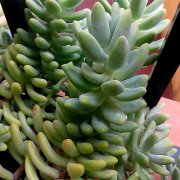Care of the succulent plant Sedum pachyphyllum or Jelly Bean Plant |
|
The genus Sedum, family Crassulaceae, comprises 350 species of succulent plants distributed in cold and temperate regions of almost the entire planet. Some species are: Sedum pachyphyllum, Sedum morganianum, Sedum dendroideum, Sedum confusum, Sedum album, Sedum moranense, Sedum clavatum, Sedum rubrotinctum, Sedum acre, Sedum sieboldii, Sedum dasyphyllum, Sedum palmeri, Sedum spurium, Sedum spectabile. Common names: Jelly Bean Plant, Blue Jelly Bean, Silver Jelly Beans, Succulent Beans. This species is native to Mexico. They are succulent plants with creeping stems that reach 25 cm (9.84") in height. The curious bluish-green leaves (with a reddish tip) are fleshy, cylindrical and curve upwards; they can come off easily if they receive even light blows. They produce yellow flowers in late winter and early spring. Jelly Bean Plant is used as cover plants in the driest and sunniest areas of the garden, in rockeries and in pots and planters for patios, terraces and balconies. It's ideal for gardens by the sea and for cities because it resists salinity and air pollution. Sedum pachyphyllum needs full sun exposure and high temperatures. It resists occasional frosts. Blue Jelly Bean can grow even in limestone soils as long as they are well drained. Water once a week in spring and summer and every 2 weeks in autumn; in winter water once a month. Fertilize in autumn with compost or with humus. This easy-to-grow plant is resistant to pests and diseases but not to overwatering that rot the roots. Sedum pachyphyllum is easily propagated by cuttings in mid spring. |
Images of the succulent plant Sedum pachyphyllum or Jelly Bean Plant |
Find plants
Sedum pachyphyllum or Jelly Bean Plant | Care and Growing
© 2026 FavThemes




